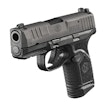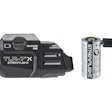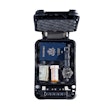For generations law enforcement has been seeking the perfect round, the so-called “magic bullet.” The ideal police weapon is a munition that could be fired at a distance to temporarily incapacitate a suspect so that he or she could be taken into custody without injury to either the suspect or the arresting officer. It would work every time, and it would be a substitute for deadly force.
Such a munition does not exist.
However, there are a wide variety of less-lethal impact munitions that officers can use to temporarily incapacitate suspects at ranges out to about 50 feet, and some even 50 yards.
A typical scenario that often calls for use of such munitions is an uncooperative subject standing approximately 15 to 30 feet away in possession of a weapon. The subject is not attacking, so the officers can’t use deadly force. Yet, he is armed and presents too much threat for the officers to use empty hands to make the arrest. He’s also too far away for the officers to employ batons, OC, or Tasers.
The solution to this problem is a less-lethal impact round. But just like a golfer has a lot of clubs to choose from in his or her bag, officers in this situation have a lot of different munitions available and have to choose the right one.
A Long-Distance Club
It’s not surprising that impact weapons used by police have evolved into stand-off ammunition. Law enforcement officers have utilized handheld impact weapons in the form of saps and clubs for more than a century.
As early as the 1960s, American law enforcement began experimenting with and using specialty impact munitions (SIMs). These first less-lethal impact munitions included everything from modified shotgun rounds to 37mm rounds that had to be fired from special launchers. The primary application for these wood or rubber baton rounds was to quell riots in residential areas and correctional facilities where tear gas would have been impractical. They were also used in conjunction with tear gas to disperse rioters.
Today, SIMs are a great addition to our use-of-force toolbox. They provide us with additional use-of-force options by extending the baton’s distance and enhancing the safety of the officers using the munitions and the subjects they are arresting.
We use SIMs during certain situations when deadly force is not justified, but there is still a high level of threat and risk of injury to the officer, the subject(s), or bystanders. Impact munitions are also used when it is not safe for an officer to close in on a subject and to control him or her physically.
The Right Tool
One of the most important decisions that you have to make when using special impact munitions is what type of round to use. There are a variety of factors that you have to consider.
You have to determine how much impact energy you need to do the job. Also, how accurate does your shot have to be to achieve the desired effect on the subject?
The shape and construction design of the SIM round used will be a major factor in both accuracy and impact punch. Some rounds are more aerodynamic than others and offer less resistance to the air during flight, thereby increasing their effective range and enhancing their accuracy.
Another major factor that affects both accuracy and impact power is the weight of the actual munition. For example, foam baton rounds are much lighter than bean bag rounds or rubber baton rounds. So generally they aren’t quite as accurate, and they don’t hit as hard.
It’s important to remember when discussing the effective range of less-lethal munitions that there may be minimum as well as maximum effective ranges to consider. If you use the munition too close to the subject, the impact may be much more traumatic than you desire. It could even be lethal.
There are several variables that determine the effectiveness of SIMs on a subject.
The size and mass of the subject is a major factor that can determine the success of a SIM deployment. A subject who weighs 150 pounds and who is shot with a 37/40mm foam baton round at a range of 14 feet will experience a different effect than a subject who weighs 314 pounds who is shot at the same range with the same round. Heavy coats and other padded clothing can also mitigate the effects of a SIM.
To achieve maximum effect, you also have to hit the subject in the right place on his or her body. This is easier said than done because SIMs are harder to shoot accurately than lethal munitions.
Once a SIM round leaves its launcher’s barrel, a specific sequence of events starts to take place. As the round moves out from the barrel, it loses velocity very quickly. This will cause a change in the trajectory and can change the expected point of impact.
The shape of the projectile will also affect the accuracy. SIM rounds come in a variety of shapes and sizes. Some are non-aerodynamic and some are aerodynamic. SIMs are square, tubular, rectangular, and oval. Some even have special features like tails and stabilizers to help increase their range and accuracy.
Applications
The law enforcement community has found excellent justifications for deploying SIMs. Bean bag rounds are commonly employed in suicide-by-cop and other incidents during which officers confront armed emotionally disturbed persons.
Tactical Teams such as SWAT or SRT have safely deployed SIMs in various high-risk situations where lethal force was not warranted or it wasn’t the best option. These have included hostage rescues, inner-perimeter security operations, and less-lethal take downs during raids. SIMs have also proven to be useful for breaking windows and patio doors for distractions or as a prelude to chemical deployment.
Crowd control and riot operations are another major application for special impact weapons. They can be used to contain, move, or rout rioters. They are also used to protect chemical munitions, provide cover for riot squad formations and crowd control personnel, as a response to looting, and for taking down individual agitators.
In corrections operations, SIMs have proven to be especially useful. COs use them to quell fights between inmates, to cover cell extractions, and to regain area control of pods, housing units, day rooms, or recreation yards during inmate disturbances.
Special Impact Munitions
Now that we’ve looked at some basics about special impact unitions, let’s look at some of the different types of munitions that are available.
12-Gauge Square Bean Bags—Square bean bag rounds are quite literally cloth bags made of special nylon or canvas that are filled with lead shot or small metal pellets.
Once they leave the shotgun’s barrel, 12-gauge square bean bags can flatten out, pancake, or even saucer. Square bean bags can be caught in crosswinds and make “J” turns (right or left). If fired into the wind, a flat bean bag can float up or dive down. When fired into a tailwind, a flat bean bag will go into a spiral motion like a cork screw.
The standard effective range for a 12-gauge square bean bag is about 25 feet.
12-Gauge Tear-Shaped Bean Bags—Often called sock rounds, tear-shaped bean bag rounds are made of Kevlar or other special lightweight materials. They are designed to have stabilizers or tails to make them more accurate.
Even though tear-shaped bean bags are designed to be more stable in flight than square bean bags, these projectiles are still susceptible to environmental factors. Once these rounds are deployed some might “J” turn with crosswinds or spiral when affected by tailwinds.
The effective range of tear-shaped bean bags is 45 to 60 feet. The rounds are marketed under such names as “Drag Stabilized,” “Super Soc,” and “Power Punch.”
37/40mm Bean Bag Rounds—The primary difference between the 12-gauge and the 37/40mm square bean bag round is, of course, size. But there are also other differences. The impact power of these munitions is much greater than a 12-gauge round, and this should always be remembered when determining if such a large bean bag is suitable for a particular application.
Typically, the projectiles used in 37/40mm rounds are constructed of special nylon or canvas closed with cotton or nylon stitching. These bags are filled with lead shot, small metal pellets, silica sand, or glass beads. Generally, these rounds weigh approximately 25 to 40 grams.
Like 12-gauge square bean bags, 37/40mm square bean bags can sometimes flatten out, pancake, or saucer. With crosswinds, they may “J” turn (right or left). If fired into the wind, they can float upward or dive downward. In a tailwind, they can go into a spiral motion like a cork screw.
The effective range on these munitions is about 25 feet.
37/40mm Baton Rounds—Made of soft foam, hard rubber, or wood, these munitions are approximately one inch in diameter.
Baton rounds are most accurate when skip fired into target areas. This is because they are really not that accurate. When leaving the barrel, they sometimes start to spin, tumble, or stop spinning, which causes them to knuckle like a spinless baseball pitch and follow the same possible movement for cross winds, head, and tail winds.
The best point of aim for these weapons is about 20 to 30 feet. As noted above, they should be skipped into the target.
Spin-Stabilized Foam Baton Rounds—This special round is available only in 40mm cartridges and can only be fired from a launcher with a rifled bore. It was developed to increase the effective range, enhance the accuracy, and stabilize the impact of foam rounds. These rounds are designed to be fired directly at the target, not skipped off the ground.
Some manufacturers state that the point of aim for their spin-stabilized batons is 10 to 30 yards. These rounds are commonly known as “R.E.A.C.T.” or the “Sponge Baton.”
Rubber Balls or Pellets—Available in both 12-gauge and 37/40mm cartridges, rubber balls and pellets are commonly used in riot control. These projectiles can be as small as .31 caliber or as big as .60 caliber. They are also available in .32 caliber, .45 caliber, and .50 caliber.
As with the baton rounds, rubber balls and pellets can be skipped into the target. Some are also designed for direct fire.
The ideal point of aim for these munitions is 20 to 30 feet. These munitions are sometimes known as “Hornets Nest” rounds or Stingers.
Dave Young is the Director of Specialized Programs for the Tactical Training Division of Fox Valley Technical College Tactical Training Division and the Director of Training for RedMan Training Gear. He has more than 20 years of combined civilian and military law enforcement and training experience and is a long-time member of the Police Advisory Board.














